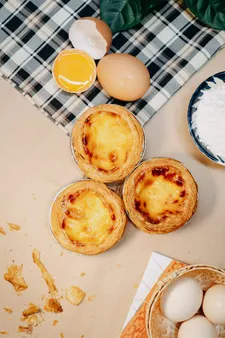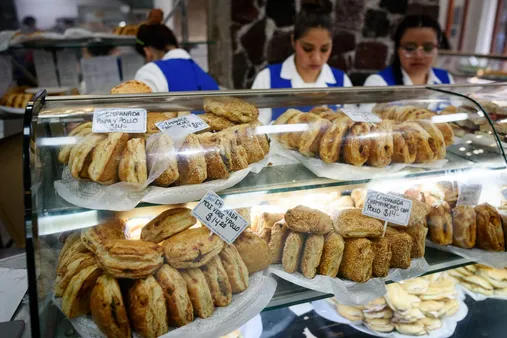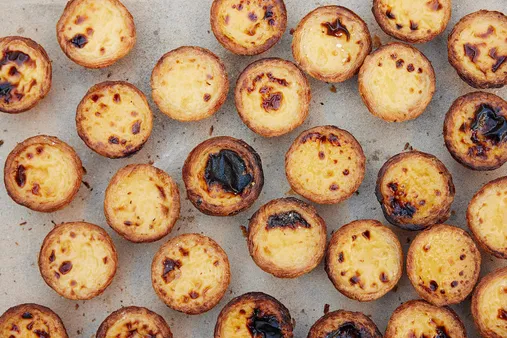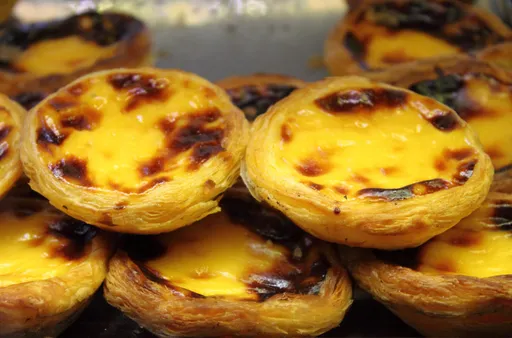Table of Contents
Welcome to tauhuichiban, where we delve into the delightful world of nata pastry. This iconic Portuguese treat is more than just a dessert; it's a cultural symbol with a fascinating history. Originating from the Jerónimos Monastery in Belém, Lisbon, nata pastry has captured hearts worldwide with its creamy custard filling and flaky crust. Join us as we explore its origins, how to make it at home, and its journey across different cultures.

Discover The Sweet Secrets Of Nata Pastry!
Origins of Nata Pastry
A Sweet Story from a Monastery Kitchen
Imagine a bustling monastery kitchen in Portugal, filled with the scent of warm spices and simmering milk. This is where the story of nata pastry begins. Centuries ago, monks at the Jerónimos Monastery in Belém, Lisbon, were known for their creative use of ingredients. They had a lot of leftover egg yolks, and instead of wasting them, they decided to whip up something special. They mixed those yolks with sugar, flour, and milk, and baked it all in a crispy, buttery crust. The result? A heavenly treat that became known as "pastel de nata," which translates to "custard tart." It was so good that the monks started selling it to visitors, and soon, it became a beloved Portuguese tradition.
From Monastery to Global Sensation
The monks' little creation quickly gained popularity, and even after the monastery was closed in the 1820s, the recipe for nata pastry lived on. In fact, the monks sold the recipe to a nearby sugar refinery, which then started producing and selling these delicious tarts. The sugar refinery eventually opened a bakery called "Fábrica de Pastéis de Belém" in 1837, and it's still going strong today! They've been making nata pastries the same way for over 180 years, and they're still considered the best in the world. It's like a secret family recipe that's been passed down through generations, and everyone wants a taste of it. Now, you can find nata pastry all over the world, but there's something special about tasting it in Lisbon, where it all began.
Year | Event |
|---|---|
17th Century | Monks at the Jerónimos Monastery in Belém, Lisbon, create nata pastry. |
1820s | Monks sell the recipe to a sugar refinery. |
1837 | Fábrica de Pastéis de Belém bakery is established. |

Origins of Nata Pastry
How to Make Nata Pastry at Home
Step 1: Make the Pastry Dough
Making nata pastry at home might seem intimidating, but trust me, it's easier than you think! The first step is to make the pastry dough. You'll need flour, sugar, and butter. Yes, you read that right - butter! You'll need to knead the dough until it becomes smooth and pliable. Think of it like playing with playdough, but much more delicious.
Once you've got your dough, you'll need to roll it out thin. This is where things can get a bit tricky. You'll need to use a pasta machine to get the dough to the right thickness. Don't worry if you don't have one, you can always use a rolling pin to get the job done.
Ingredient | Quantity |
|---|---|
Flour | 2 cups |
Sugar | 1 cup |
Butter | 1/2 cup |
Step 2: Make the Custard Filling
Now it's time to make the custard filling. This is the fun part! You'll need to simmer milk, cream, and sugar until it thickens. Then, you'll need to mix in some egg yolks and vanilla extract. Yes, it's a bit like making a cake, but the end result is so worth it.
Once you've got your custard filling, you'll need to pour it into the pastry dough. This is where things can get a bit messy, but don't worry, it's all part of the process.
- Simmer milk, cream, and sugar until it thickens
- Mix in egg yolks and vanilla extract
- Pour into pastry dough

How to Make Nata Pastry at Home
Nata Pastry Around the World
As nata pastry gained popularity, it didn't stay confined to Portugal's borders. This sweet treat traveled far and wide, becoming a beloved dessert in many countries. In Macau, a former Portuguese colony, you can find a unique variant of nata pastry, often served with a crunchy cookie crust. In Indonesia, particularly in Kampung Tugu, Jakarta, nata pastry is a popular snack, often enjoyed with a cup of coffee.
But that's not all! Even international chains like KFC have jumped on the nata pastry bandwagon, offering their own version in several Asian regions. It's amazing to see how this traditional Portuguese dessert has become a global phenomenon, bringing people together with its creamy goodness.
Country | Nata Pastry Variation |
|---|---|
Macau | Crunchy cookie crust |
Indonesia | Served with coffee |
Asia (KFC) | Macanese-style nata pastry |
- The Guardian listed pastéis de Belém as one of the 50 "best things to eat" in the world in 2009.
- Nata pastry was announced as one of Portugal's Seven Wonders of Gastronomy in 2011.

Nata Pastry Around the World
Final Thought
Nata pastry is not just a delicious dessert but also a testament to culinary innovation and cultural exchange. From its humble beginnings in a monastery kitchen to becoming one of Portugal's Seven Wonders of Gastronomy, this egg custard tart continues to enchant palates globally. Whether you enjoy it dusted with cinnamon in Lisbon or try your hand at making it at home using our guide, nata pastry offers an enriching gastronomic experience that reflects Portugal's rich culinary heritage.